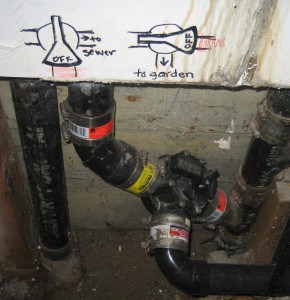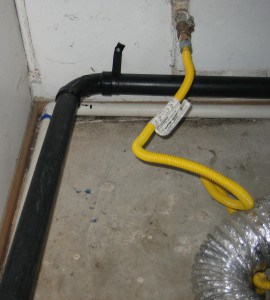Branched Drain System from Shower: Exposed Pipes
Site location: Oakland, CA
- Goals: To reduce water use and grow fruit.
- Site description: The plumbing from the shower is exposed in the unfinished laundry room downstairs. There is enough height to travel outside to the landscape. The yard is already planted with fruit trees, fruiting vines, and veggie beds.
- Fixtures and output: One shower that is used for about 10 minutes per day (2.5 gallons/minute X 10 min= 25 gallons).
- Cost: One 1 1/2″ – 2″ 3-way valve- $50, fittings-$75, pipe-$75: material total: $200 (costs updated for 2018. Costs range between $150 and $350 for this type of system depending on the size of system, and more if the valve is controlled with an actuator). No mulch or plants were purchased for this system.
The plumbing from the shower was exposed in this section of wall. The pipe is cast iron, it’s connected with transition couplings, often called “no-hub” couplings. They can be loosened and removed with out the need to cut the pipe.
One section of cast iron pipe was removed. The 3-way valve is inserted in this section before the shower drain connects to the sewerline. In this picture the bands on the right are tightened and the band on the upper left is positioned but loosened in order to get the measurement of the pipe needed to connect the valve.
The valve is connected with no-hub coupling. Now the shower water can either flow to the sewer (the pipe going into the floor), or outside through the new section of pipe exiting in front of the valve. The illustration of the valve’s positioning shows how to control the flow of greywater.
The shower water travel outside in an 1 1/2 inch ABS pipe with a continuous downward slope of 2% (1/4 inch per foot). The pipe is strapped to the wall. The hole going out is sealed with a waterproof silicon sealant from the outside to prevent moisture, air, or insects from entering the house.
Once outside the greywater pipe is buried, sloping downward as it travels to the plants.
This system divides the water to irrigate 4 locations, one apple tree, one tree tomato, one passion fruit, and one section of climbing beans (along a trellis).
The fruit trees have mulch basins dug around them in their drip line.
Greywater is discharged into the mulch basin inside a valve box. The basin is filled with wood chips. In this “one year later” picture the greywater is being discharged underneath the blue rectangular container in front of the tree.
The fruiting vines growing up the trellis have a mulch trench, instead of a circular basin. The trench is filled with woodchips and receives the greywater.
- Maintenance and trouble shooting: Annual replacement of mulch.












